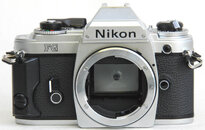Yet another rumor about the Nikon response to Olympus/Panasonic micro-four-thirds cameras:
DSLR Magazine
translated into English:
Google Translate
Basically, it says Nikon will introduce a new camera system (multiple bodies, multiple lenses) in March of 2011. The new system will be smaller than existing Nikon SLRs, but be more "professional" than micro-four-thirds or NEX cameras. If Nikon uses their old A-style rangefinder lens mount, there might be a way to use Nikonos lenses with this camera. It would also be really nice if Nikon made an adapter to use the R-UW lenses for the SLR-Nikonos, but that's probably too much to ask.
Nikonrumors.com also has rumors about interchangeable sensors (a la Samsung NX), curved image sensors, multi-sensor cameras, cameras where the sensor can rotate 90 degrees from portrait to landscape while the camera body stays still, lenses that can be zoomed either manually or electrically, and other weird stuff. The electrically zoomed lenses could be interesting for underwater, eliminating the need for zoom gears.
DSLR Magazine
translated into English:
Google Translate
Basically, it says Nikon will introduce a new camera system (multiple bodies, multiple lenses) in March of 2011. The new system will be smaller than existing Nikon SLRs, but be more "professional" than micro-four-thirds or NEX cameras. If Nikon uses their old A-style rangefinder lens mount, there might be a way to use Nikonos lenses with this camera. It would also be really nice if Nikon made an adapter to use the R-UW lenses for the SLR-Nikonos, but that's probably too much to ask.
Nikonrumors.com also has rumors about interchangeable sensors (a la Samsung NX), curved image sensors, multi-sensor cameras, cameras where the sensor can rotate 90 degrees from portrait to landscape while the camera body stays still, lenses that can be zoomed either manually or electrically, and other weird stuff. The electrically zoomed lenses could be interesting for underwater, eliminating the need for zoom gears.





